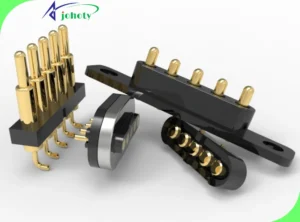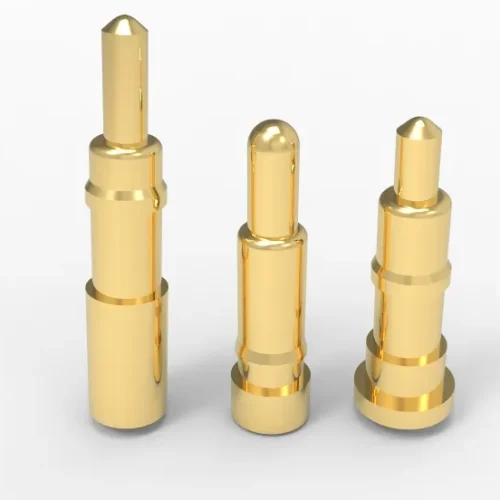5 pin electrical connector: Unveil the essence of data and power transmission in car electrical systems! From design principles to real-world applications, delve into technical advantages. Unlock insights in automotive engineering with expertise!
5 pin electrical connectors, pivotal components in modern automotive electronic systems, efficiently transmit data and reliably deliver power. Their precision design ensures stability and dependability, catering to diverse automotive applications like engine management, body control, and infotainment systems.
This article delves into their technical features and engineering applications, providing engineers with valuable resources for solutions and innovative inspiration. Dive in now to explore cutting-edge technologies and trends in automotive engineering
Introduction: 5 Pin Electrical Connector Transfers Data and Power in Cars
- The 5 pin electrical connector is a critical component in automotive electrical systems. It excels in efficiently transmitting data and reliably delivering power.
- Its precision design ensures system stability and dependability, making it highly suitable for complex automotive applications. Examples include engine management, vehicle handling, and entertainment systems.
- The 5 pin electrical connector integrates advanced electronic technologies to enhance driving experiences with increased efficiency, safety, and intelligence.
- Within this intricate system, the 5 pin electrical connector plays an indispensable role. It not only facilitates efficient data transmission but also reliably powering various components.

This article delves into its technical features and engineering applications, providing engineers with valuable resources for solutions and innovative ideas. Read on to explore the latest cutting-edge connectivity solutions and application trends in the automotive electronics field!
What is 5 Pin Electrical Connector in Automotive Electrical Systems?
When transmitting data and power within automotive electrical systems, its physical structure and electrical characteristics become particularly crucial. Engineers commonly apply this type of connector in communication links between automotive electronic control units (ECUs), sensors, and actuators.

Physical Structure:
Plug and Socket Design:
- Typically comprising a pair of plug and socket, where the plug connects to the cables and the socket is fixed onto the device or control unit.
- The design of the plug and socket ensures proper alignment and secure connection to prevent disconnection due to vibrations or environmental conditions.

Housing Material:
- Typically, the housing is crafted from materials that withstand high temperatures and chemical wear. Suitable for harsh environments found in automotive engine compartments and electrical systems.
Sealing Performance:
- Connectors generally feature excellent sealing to prevent moisture and dust ingress, thereby ensuring reliable long-term use.

Electrical Characteristics:
Pin Functions:
- Each pogo pin in the 5 pin electrical connector serves specific electrical functions. Such as power supply, ground, and data signal transmission.
- Standard pin and color coding schemes are often employed to allow engineers quick identification and connection during installation and maintenance.
Current and Voltage Capacity:
- Connector designs take into account the current and voltage requirements for safe and stable power transmission within automotive systems.

EMI Resistance:
- For data transmission lines, design connectors with good EMI resistance to maintain data reliability and accuracy in electrically noisy environments.
Durability:
- Connectors must withstand thousands of connect-disconnect cycles while maintaining reliable electrical contact stability. Standards Compliance:
- These connectors typically adhere to specific automotive industry standards, such as SAE J1939, ISO 11898. Facilitating interoperability among devices and systems from diverse manufacturers.

How does the 5 pin electrical connector simultaneously transmit data and power in automotive electronic systems?
1. Physical Structure and Function Allocation:
- Plug and Socket Design: 5 pin electrical connectors typically consist of plugs connecting to cables and sockets fixed onto devices or control units.
- Pin Functions: Each pin in a 5 pin connector is assigned specific electrical functions. These often include power supply (such as power and ground) and pins dedicated to data communication. For instance, some pins may transmit CAN bus data while others handle power and ground lines.

2. Data Transmission:
- CAN Bus Technology: In modern automotive electronic systems, data between control units is commonly transmitted via the CAN bus. CAN bus is a widely used serial communication protocol suitable for real-time applications like vehicle control and monitoring systems.
- Data Transmission Pins: Connectors are designed with pins specifically for CAN bus communication. These pins manage the transmission and reception of control information, such as for engine management, braking systems, and climate control.
3. Power Transmission:
- Power Supply Pins: Apart from data transmission, other pins in the 5 pin electrical connector handle power transmission. These pins supply power, such as providing power and ground, to support the normal operation of connected devices.
- Voltage and Current Capacity: Connector designs consider the voltage and current requirements within automotive electrical systems to ensure safe and stable power delivery.
4. Design Considerations:
- EMI Resistance: Connectors must exhibit strong EMI resistance to ensure EMI in the automotive environment doesn’t affect data transmission and power stability.
- Durability: Connectors must endure thousands of connect-disconnect cycles while maintaining reliable electrical contacts. Capable of withstanding vibrations and temperature variations during vehicle operation.
5. Standards Compliance:
- These connectors typically conform to specific automotive industry standards, such as SAE J1939, and ISO 11898. Ensuring interoperability and compatibility between equipment and systems

5 pin electrical connector in high temperatures and high humidity in automotive electronic systems:
Performance of the 5 pin electrical connector in High-Temperature Environments:
1. Material Selection and Heat Resistance:
- Connector housing materials typically include heat-resistant engineering plastics or metals. They can withstand high temperatures near engine compartments and exhaust systems.
- High-temperature seals ensure that the internal electrical components of the connector remain undamaged and maintain stable electrical performance.
2. Electrical Performance Stability:
- Selection of Conductive Materials: Internal conductive components, such as pins and sockets are made from materials that maintain conductivity at high temperatures. Such as heat-resistant alloys.
- Contact Stability: Ensures that electrical contacts of the connector remain stable in high-temperature environments. Preventing poor connections or increased resistance due to temperature changes.
3. Thermal Expansion Management:
- Design Considerations: The design of connectors includes adjustments for the thermal expansion characteristics of the materials used. This ensures the connector’s physical structure does not fail or become damaged during temperature fluctuations.
Performance of the 5 pin electrical connector in High-Humidity Environments:
1. Waterproof Performance:
- Sealing Design: Connectors typically feature excellent waterproof and moisture-proof capabilities, utilizing seals, silicone fillings, etc., to prevent water and moisture ingress.
- IP Rating Protection: Compliance with IP67 or higher standards ensures the connector maintains good operational status even in high humidity conditions.
2. Corrosion Resistance:
- Material Selection: Corrosion-resistant materials, such as tin-plated or gold-plated electrical contact points prevent corrosion caused by moisture and chemicals. Maintaining long-term stable electrical connections.
3. Reliability Testing:
- Humidity and Heat Cycling Tests: Connectors undergo humidity and heat cycling tests during the design phase. This simulates high-humidity, high-temperature environments, verifying their reliability and durability.
Other Considerations:
- Vibration and Shock: Connector designs are engineered to endure vibrations and shocks experienced during vehicle operation, ensuring stable connections and lasting reliability.
- Maintenance and Lifespan: Designed for simplified maintenance and replacement to reduce downtime and repair costs caused by environmental conditions.
The stability and reliability of 5 pin electrical connectors in automotive electronic systems under high-frequency and high-speed data transmission:
1. Challenges of High-Frequency and High-Speed Data Transmission of the 5 pin electrical connector
Data Transmission Rate:
- Applications: Connectors are used for transmitting high-speed data such as high-resolution video signals, high-speed sensor data, etc.
- Transmission Rate: Data transmission rates can reach several hundred kilobytes per second (KB/s) or even higher. Requiring connectors capable of supporting these high data transfer rates.
Signal Integrity:
- Impedance Matching: Connector designs must consider impedance matching of signal lines to ensure signal integrity and stability at high frequencies.
- Signal Attenuation: Minimizing signal degradation during transmission to uphold data accuracy and reliability.
EMI Suppression:
- Shielding Design: Connectors employ shielding designs or use shielding enclosures to reduce or suppress EMI from surrounding environments or other electronic devices.
- Suppression Measures: Using double-layer shielding or materials with enhanced shielding effectiveness, ensuring stable data signal transmission in high-frequency environments.
2. Design and Engineering Solutions of the 5 pin electrical connector:
Materials and Manufacturing Processes:
- Conductive Material Selection: Using high conductivity and low resistance materials, such as metal alloys or special coatings. It is to reduce resistance and losses during signal transmission.
- Precision Manufacturing: Ensuring precise manufacturing processes for connector pin spacing, insertion force, and contact pressure. It meets design requirements, enhancing connection stability and reliability.
Testing and Validation:
- High-Frequency Testing: Connectors undergo high-frequency testing during the design phase to verify performance at specified data transmission rates.
- EMI Testing: Conduct EMI testing to assess the connector’s ability to withstand interference in real-world operating environments. Ensuring compliance with standards and specifications.
Thermal Management:
- Thermal Dissipation Design: Including effective thermal dissipation measures in connector design to manage heat accumulation potentially caused by high-speed data transmission. Ensuring performance is not compromised during prolonged use.
3. Technological Advantages to Address Challenges of the 5 pin electrical connector:
- Low Insertion Force and Contact Resistance: Optimized connector designs reduce mechanical stress during insertion and contact resistance, ensuring stable data signal transmission.
- High-Quality Materials and Environmental Sealing: Use high-quality materials and effective environmental sealing to protect the internal electrical components of the connector from external conditions.
- Standardization and Compatibility: Conformance to international standards and industry specifications ensures connectors are compatible with various equipment and systems. Enhancing overall system integration and interoperability.
Development and innovation of the 5 pin electrical connector in automotive electronic systems:
1. Technological Development Directions:
Enhanced High-Speed Data Transmission Capability:
- The future 5 pin electrical connector will support current high-speed data transmission demands, and increase data transfer rates and bandwidth.
- To meet the needs of autonomous driving systems for real-time high-definition video, sensor data, and other high-capacity data.
Improved EMI Resistance:
- Addressing complex electromagnetic environments, future connectors will enhance their EMI resistance capabilities.
- By employing advanced shielding technologies and signal processing algorithms to ensure stability and reliability in data transmission.
Intelligence and Self-Monitoring Capability:
- Introducing intelligent designs that enable connectors to automatically detect and diagnose connection statuses, electrical characteristics, and potential faults. Enhancing system self-monitoring and predictive maintenance capabilities.
Optimization of Materials and Manufacturing Processes:
- Leveraging advanced materials science and manufacturing processes to further reduce connector weight and size.
- Enhance durability, and improve thermal management capabilities, adapting to more complex and high-density layouts in automotive electronic systems.
2. Innovative Applications and Impacts:
Autonomous Driving Systems:
- In autonomous vehicles, the 5 pin electrical connector will connect high-precision sensors, data processing units, and actuators. This ensures real-time data exchange and facilitates control command transmission.
- Their stability and high-speed data transmission capabilities will directly impact vehicle response speed and safety performance.
Intelligent Traffic Systems:
- In intelligent traffic systems, connectors will link vehicles to communication networks with infrastructure. Enabling data exchange and cooperative operations between vehicles and road facilities.
- Traffic signal control and road condition feedback will rely on the stable data transmission capabilities of the connectors.
Integration with Vehicular and IoT Networks:
- Serving as bridges between vehicles and external IoT devices, connectors will facilitate the development of vehicle intelligence and connectivity.
- Future connectors will support broader protocols and communication standards to seamlessly integrate vehicles into smart cities and intelligent transportation networks.
Energy Efficiency and Environmental Impact:
- Technological advancements in connectors will contribute to enhancing the energy efficiency of vehicle electronic systems, reducing energy consumption and emissions.
- Improved designs and material choices will also lessen resource consumption and environmental impact.
Conclusion and Outlook: 5 Pin Electrical Connector Transfers Data and Power in Cars
Through comprehensive analysis of the functions, applications, and technological developments of the 5 pin electrical connector in automotive electronic systems:
Key Functions and Applications:
- The 5 pin electrical connector plays a crucial role in automotive electronic systems by transmitting both data and power. As well as connecting various control units, sensors, and actuators.
- The reliability of their data transmission and power supply directly affects the performance, safety, and efficiency of modern vehicles.
Technological Development Trends:
- In the future, the development of the 5 pin electrical connector will focus on enhancing data transmission rates. Improving EMI resistance, implementing intelligent monitoring capabilities, and optimizing materials and manufacturing processes.
- These technological advancements will drive automotive electronic systems toward higher efficiency and greater intelligence. Supporting the realization of autonomous driving technology and intelligent transportation systems.
Impact and Application Areas:
- Innovative applications of the 5 pin electrical connector will profoundly influence autonomous driving. Intelligent transportation systems, and the integration of vehicular and IoT networks.
- They are poised to significantly improve driving experiences and streamline traffic management. Enhancing energy efficiency and advancing environmental sustainability will pave the way for smart city and intelligent transportation network growth.
Looking Ahead to the Future:
- As technology advances and the automotive evolves rapidly, the 5 pin electrical connector will continue to be key electrical interfaces.
- We look forward to seeing further applications and innovations in autonomous driving technology, intelligent transportation systems, and vehicle intelligence. Bringing unprecedented possibilities and opportunities to the industry.
- We welcome you to stay connected by following our blog and receiving our updates. Let’s explore together the future development of the 5 pin electrical connector in automotive electronic systems!
Contact Us:
- If you have any inquiries or project needs regarding the application of the 5 pin electrical connector in automotive electronic systems. Please reach out to us at your convenience, our dedicated CFT team is standing by to assist you and provide solutions.













